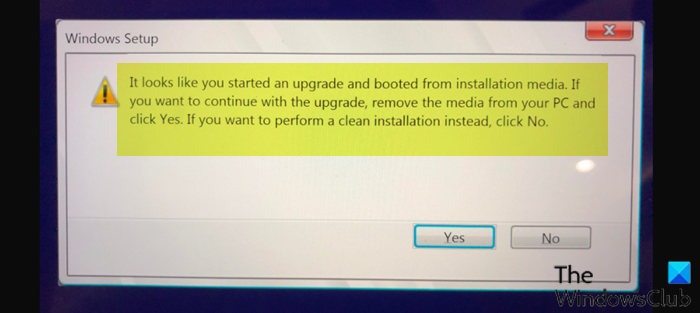If your Windows PC won’t boot, and you boot your Windows system using a flash drive to repair the Windows installation, but receive an error prompt with the message It looks like you started an upgrade and booted from installation media, then this post is intended to help you with suggestions you can try to get past this block and successfully repair your Windows 11 or Windows 10 computer.

When you encounter this issue, you’ll receive the following full error message;
Windows Setup
It looks like you started an upgrade and booted from installation media. If you want to continue with the upgrade, remove the media from your PC and click Yes. If you want to perform a clean installation instead, click No.
How do I fix The upgrade option isn’t available?
You’ll notice that the upgrade option isn’t available if you start your computer using installation media. So, if a copy of Windows is already installed on your Windows 11/10 computer and you want to upgrade that machine, you need to remove the installation media and restart your computer. After Windows has started normally, you can then insert the installation media and run Windows Setup.
It looks like you started an upgrade and booted from installation media
If you’re faced with this issue on your Windows 11/10 computer, you can try our recommended solutions below, in the order presented to resolve the issue.
- Perform System Restore
- Perform the repair using Windows 11/10 ISO file
- Clean install Windows 11/10
Let’s take a look at the description of the process involved concerning each of the listed solutions.
Before you try any of the solutions below, you can just hit the Esc key on your keyboard at the error prompt; it will let you proceed to other options and you can now continue with the repair operation. Some affected users reported this worked for them!
If you cannot boot Windows normally, you may have to try and boot in Safe Mode or into the Advanced Startup options screen to be able to carry out the fixes. You will need to make use of the Command Prompt. For some strange reason if you can boot in Safe Mode but cannot access the Advanced Startup Options screen, when in Safe Mode, you may use the Command Prompt to boot Windows directly to the Advanced Startup Settings screen.
1] Perform System Restore
This method of system restore isn’t the usual run-of-the-mill procedure, since your Windows 11/10 computer was unable to boot before you decided to create a bootable installation media to repair your computer. So, if you have made some changes prior to the PC not booting successfully to the desktop, you can perform System Restore when Windows won’t boot to the desktop.
This procedure should get your system up and running; if not, proceed with the next solution.
2] Perform the repair using Windows 11/10 ISO file
This solution entails you simply bypass performing the repair using removable media, and instead use the Windows 11/10 ISO file – bear in mind that this procedure requires you to boot to the desktop. So, if you’re able to get your system restored using the procedure above, but you still want to repair your current installation, you can directly download the Windows ISO image file from the Microsoft website. Once you have downloaded the ISO to a location (preferably the desktop) on your PC, double-click the ISO image to mount it as a virtual drive then double-click the setup.exe file to start the in-place upgrade process with the ISO file.
3] Clean install Windows 11/10
If at this point you’re still stymied by the It looks like you started an upgrade and booted from installation media issue from repairing Windows, you can back up your data (since you’re unable to boot to the desktop, you can recover files when Windows won’t boot or use Linux Live USB to retrieve your files), then create a fresh installation media with the latest version of Windows 11/10 and then perform a clean install on your device.
In the event you do not have a USB flash drive handy, you can install Windows from your Android smartphone using DriveDroid.
Hope something helps!
Will reinstalling Windows 10 delete files?
Reinstalling Windows 11/10 won’t delete files per se. All of your files and software will be retained, but the reinstallation will delete certain items such as custom fonts, system icons, network credentials et al. However, as part of the process, the setup will also create a Windows.old folder which should contain everything from your previous installation – so, you can access this folder and restore items that you might need.
Related post: The computer started using the Windows installation media.
Leave a Reply